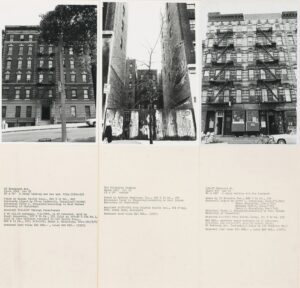
The New Art Examiner is difficult to explain, as it does not fit into convenient categories. I refer to our Statement of Purpose, printed in every issue since the first one. These profound words were written by a forgotten hero, Edward Fry, the Curator and Art Historian who defied the Trustees of the Guggenheim Museum in New York. He lost his job as the Trustees decided to dismantle an exhibition of Hans Haacke, a pioneer and important conceptual artist exhibit, on the grounds it was not art. The exhibition included photographs of slum property of which some of the trustees had a financial interest. Hans Haacke made his point; hypocrisy was rife and dominant in the upper echelons of society. It still is. Conceptual artists have made similar points, most noteworthy Marcel Duchamp, but he chose a different target: artists.
The arrival of Donald Trump has made so much so clear. Our political crisis is also a cultural crisis, corruption. The story of Trump can be reduced to the simple fact that he got elected riding on the resentment of the electorate who believe that Washington as the seat of government is not responsive to their plight. He called Washington a swamp. I agree. But Donald has made his own swamp, which looks more toxic than Hillary’s result in the loss of leadership that the USA once enjoyed.
Art criticism is only words written by those who have a love of art. Critics are not different from artists, in that they come in all sorts of shapes and guises, with opinions sometimes informed and sometimes not. Art critics can be profound and banal, modest and arrogant and sensitive to art. Artists resent critics when they do not praise their art. Critics are seen as authoritative figures. The critic differs from the artist in that his practice is in the public domain, while the artist can retreat, enjoy the space, calm and even the sanctuary of the studio.
The Elephant in the Art World room is the issue of patronage. Or better still can today’s market find informed patronage? Artists need patrons.
There are creative, sensitive patrons and there are also not so clever, patrons. Today artists have to rely on the rigged market and it is declining.
The role and purpose of critical discourse has been relegated to obscurity. In part, mass culture is more effective at gaining votes, money and celebrity. Here I cite Jeff Koons as a banal superstar, who recently announced he was not making art any more. Artists should understand they are disposable as financial items; this is the fate of modernism. Since the Academies fell, artists have nothing to sell but an idea of art. The 19th century Academies were very confident in sharing their taste of acceptance or rejection. Academies and Museums are secretive and not transparent in the selecting and making of shows, as was the CIA when it underwrote Abstract Expression. Nobody makes the final definition of Art. Art is like pornography; we can recognize it when we see it but cannot define it.
Fashionable, contemporary art can fetch ridiculous prices as did the mania for tulips. Culture is not based on trade, though trade facilitates culture.
It encompasses something else. It is a manifestation of human values. It is quite possible when our forefathers took certain steps of evolution that art and language seeped into their being and thinking, arguably the dawn of religion, which cannot be quantified. Art is the icon or material presence of belief systems.
Bourgeoisie culture has the choice to be informed or not informed; to be progressive or retrenched is the question. Washington is the apex of bourgeoisie culture. Politicians, like Wall Street, are allergic to uncertainty. Art deals with uncertainty. It explores uncertainty. It finds form for uncertainty. This is the magic of art.
Derek Guthrie
Volume 34 no.2 November/December 2019 pp 17-18

A top tier curator wrote that no one knows what art is anymore, but every other profession knows what they’re doing. I think we should give it a try. I’m assuming a good work of art attracts our attention so we don’t have to be scolded into looking at it, and I’m hoping good art makes a statement, so we don’t have to be told what to think about it.
Recently I’ve been reading how the intellect is located as a left brain activity while the right brain is subtlety and shading, creativity and feelings, but has no speech centres. So that could be the reason it’s hard to define art, because art occurs in non-verbal forms. Art looks like a right brain activity that is not optimized for intellectual explanations. Which says specific things about new directions for the future of art.
Great article from Guthrie! Art is like pornography; you can recognize it when you see it, but you can’t define it. Can’t believe you actually mentioned the CIA’s role in the abstract expressionism movement.